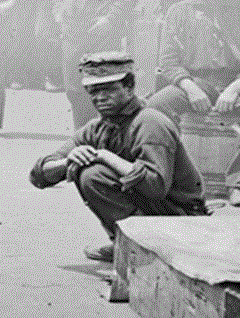CARTER-SIAH
SIAH CARTER

LANDSMAN

DECEASED, 1892
Siah Carter, also known as Josiah Hulett, was an African-American slave reportedly born in 1838 in Charles City, Virginia. He was a slave on the Shirley Plantation in Charles City owned by Hill Carter a Confederate Army colonel, and as was the traditional custom, Siah used his master’s surname and this was the name he used while in the Union Navy. During the early 1860’s a number of slaves escaped from Shirley Plantation and Carter later stated that his master had called all the slaves together and told them, “that if any of them went on board the Yankee ships, the Yankees would carry them out to sea, tie a piece of iron about their necks and throw them overboard.” Ignoring the warning, Siah slipped away from the plantation in May 1862 and boarded a small boat with the intention of reaching the ironclad USS MONITOR at anchor nearby in the James River.
It must have taken quite an effort to reach the MONITOR which was low to the waterline and thus vulnerable to attack with sentries posted on deck and surrounded by larger, heavier ships, all with sentries posted overnight. An officer aboard MONITOR later wrote a letter to his wife describing the moment he saw a slave become a free man. He said he was below decks late at night on May 16, 1862, when he heard someone shout, “Boat Ahoy.” This was followed by the shout, “Boarders,” and the crack of a rifle. Instantly a stampede followed from below decks as the crew and officers gathered on deck to fend off the attackers. The officer wrote that a voice cried out from a nearby boat, “O, Lor’ Massa, oh don’t shoot, I’se a black man Massa, I’se a black man.” With that Siah pulled alongside and boarded MONITOR. Siah was not necessarily free as he was not the first slave who had come to MONITOR begging to enlist. Officially the Fugitive Slave Act was the law of the land and many fugitives to slavery had been denied their requests. However, MONITOR’s captain saw something in Siah and brought him on board and he joined the Union Navy as a “first class boy,” one of the Navy’s first enlisted “contrabands” as the former slaves were called. Once aboard MONITOR, Siah was assigned various duties as a coal heaver, carpenter and assistant to the cook. He was reportedly skilled in these areas and an asset to the crew as these were some of his occupations as a slave.
In late December 1862, MONITOR was ordered south to support a Union attack on Wilmington, North Carolina. After waiting for the weather to clear she left Hampton Roads under tow on December 29, 1862. The ship was unusual in almost every respect, was built with a hull of very low freeboard, with a large cylindrical gun turret mounted amidships and designed to present the smallest possible target to enemy gunfire. She was designed for shallow rivers and thus not seaworthy on the open ocean. On December 31, 1862, as storm seas began to build as she passed Cape Hatteras, the unseaworthy MONITOR began shipping water from her many leaks and when water reached the fires on board all power was lost. Soon MONITOR founder and sank with a loss of 16 crewmembers. Fortunately Siah was one of the survivors. He was next assigned to the three-masted storeship USS BRANDYWINE and later to the side-wheel steamboat USS FLORIDA where muster rolls list him as Landsman. He later wrote of his utter feeling of freedom and peace that he felt being away from his master and working for the Union. He was discharged from the Union Navy in May 1865 and returned to Shirley Plantation to wed a former slave, Eliza Tarrow. They eventually settled in Bermuda Hundred, Virginia, and raised thirteen children. Siah died in 1892. The location of his final resting place has not been recorded.
Submitted by CDR Roy A. Mosteller, USNR (Ret)

